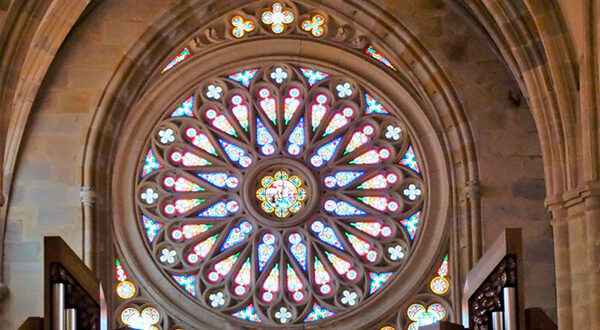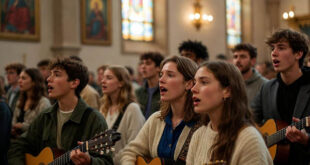“He has made everything appropriate to its time, and He has put eternity in their hearts.”
— Ecclesiastes 3:11
Introduction: When Stone Preaches
At first glance, a Gothic rose window may seem like nothing more than an ornamental feature: a burst of shapes, colored glass, and symmetrical patterns high atop a cathedral. Yet to one who contemplates with the eyes of the soul, it becomes clear that this is no mere decoration—it is a theological lesson carved in stone and light. The circle that dominates these rose windows is not the result of randomness or the aesthetic whim of a medieval architect. It is a bold, silent, and permanent affirmation of a spiritual truth: God is eternal, perfect, and central.
This article is an invitation to look again, to contemplate more deeply what we may have taken for granted. For in the Gothic rose windows, sacred geometry becomes visual catechesis, silent prayer, and a guide for our inner life.
1. The Circle: Universal Symbol, Christian Expression
Since antiquity, the circle has been regarded as a symbol of eternity, unity, perfection, and divinity. It has no beginning and no end, no corners or interruptions. Its curvature never changes, and it does not break: it is complete in itself.
In pagan traditions, this symbolic power was already intuited. But Christianity—as it has done so many times—did not destroy these ancient meanings. Instead, it assumed them, redeemed them, and elevated them. The circle became a privileged image to speak of the One and Triune God, of the infinite love of Christ, of the eternal life promised, and of the harmonious unity of creation.
At the heart of medieval sacred art, this symbol found its greatest expression in Gothic rose windows, especially from the 12th century onward.
2. The Rose Window: A Window to Heaven and a Map of the Soul
The rose window is far more than a circular stained glass window. It is a window into mystery, a geometric revelation of the divine.
Generally located on the western façade (above the main entrance), the rose window is the first thing a worshipper sees when approaching the church. And this is no coincidence: it prepares us to enter the mystery of God, reminding us that everything we are about to experience inside the cathedral—Word, Sacrament, prayer—is oriented toward an eternity without shadows.
Each element of the rose window carries meaning:
- The outer circle represents the eternity of God.
- The rays or petals radiating from the center refer to the Son, who radiates the light of the Father.
- The central point symbolizes Christ, the center of the cosmos and of history (cf. Colossians 1:17: “All things were created through Him and for Him”).
Moreover, in more elaborate rose windows, the apostles, evangelists, saints, and even biblical scenes are represented around the center, like stars revolving around the sun. It is a visual reminder that the Christian life revolves around Christ—and that only from Him does everything make sense.
3. Theological Geometry: Numbers, Proportions, and Faith
In the Middle Ages, there was no separation between art, science, and theology as we know today. For Gothic architects—many of them clerics or trained in monastic schools—design was prayer, and geometry was a language to speak of God.
The circle was not drawn at random. Compasses were used with mathematical precision because it was believed—rightly so—that beauty derived from order reveals God.
St. Bonaventure said the entire universe is like a book written by God for us to contemplate. And this applies especially to Gothic architecture. Every measurement, every number, every circular trace was meant to reflect the harmony of the Creator.
👉 The number 12, for example—frequently found in the petals or compartments of the rose window—represents the apostles, the tribes of Israel, the fullness of God’s People.
👉 The number 3, often present in internal divisions, points to the Trinity.
👉 The number 7, symbol of spiritual perfection, appears in repeated patterns.
Thus, sacred geometry is not superstition. It is a way of expressing what the Word teaches and what the soul intuits.
4. Light That Teaches, Color That Transforms
The rose window is not just form: it is light. And this light is not neutral—it is colored, nuanced, symbolic.
The stained glass transforms sunlight into a theological message. Blue points to the Virgin Mary and to Heaven; red, to the sacrifice of Christ; green, to hope and new life; gold, to divine glory.
When this light falls upon the floor of the church, it is as if Heaven touches the earth. And one who prays within, surrounded by these colors, feels something that goes beyond words. The soul is lifted.
And it is no coincidence that all this is arranged in circular form. For the light of God does not arrive linearly or hierarchically, but radiates from the center to all equally. Christ, Sun of Justice (cf. Malachi 4:2), shines for all.
5. Spiritual Application: How to Live the Circle in Our Daily Life
The circle is a symbol of God. But it can also be a model for our spiritual life. How?
a) Place Christ at the Center
As in the rose window, everything must revolve around Jesus. It’s not about having many “religious” things in your life, but about ensuring that your entire life is centered on Him. Prayer, work, relationships, decisions—everything must radiate from that center.
b) Seek Harmony
The Christian life is not chaos. It is a loving order. The circle reminds us that each part of our life has a place, a time, a proportion. Ask the Holy Spirit to help you live with balance and meaning.
c) Aspire to Eternity
We live in a linear world, full of hurry and expiration dates. The circle invites you to look beyond. Live each day with an eternal horizon. Holiness is not an unreachable goal—it is a constant direction.
d) Surround Yourself with Light and Beauty
Make your home and your life a small rose window. Surround yourself with things that lift the soul: an open Bible, a sacred image, inspiring music, time for silence. Let the light of God color your days.
6. A Theology You Can Touch
In times when many seek meaning and faith often seems like a thing of the past, looking at a Gothic rose window is an act of resistance and hope. It is a rediscovery of a theology that does not impose, but reveals itself in beauty.
And it teaches us a powerful truth: God is perfect, eternal, central, and invites us to enter into His harmony. Not to become uniform pieces, but to occupy our unique place in His circle of love.
Conclusion: Seeing with New Eyes
Next time you see a Gothic rose window—either in person or in an image—do not view it as mere architectural ornament. See it for what it truly is: a prayer in stone, a sermon in colors, a theology without words.
And let it inspire you to order your life like that rose window: centered in God, harmonious in its parts, open to light, and oriented toward eternity.
“You, Lord, are my light; the Lord illuminates my darkness.” (Psalm 18:29)






